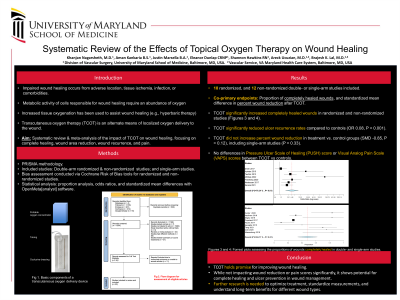Evidence-Based Practice
(EBP-008 (GR-008)) Systematic Review and Meta-Analysis of the Effects of Transcutaneous Oxygen Therapy on Wound Healing

Transcutaneous oxygen therapy (TCOT) is a newly introduced adjunct to treat cutaneous wounds secondary to a variety of causes. The purpose of this study was to conduct a systematic review and meta-analysis to evaluate the effects of TCOT on wounds of any etiology.
Methods:
A systematic review and meta-analysis was conducted on articles related to wounds treated with TCOT, using PubMed, MEDLINE/OVID, Cochrane database, and Google Scholar. We included reports of randomized controlled trials, double-arm prospective studies, single-arm prospective studies, case-control series, and case reports published on or after 2012. Articles that utilized other means of delivering oxygen to the wound, such as hyperbaric oxygen therapy or ozone therapy, were excluded.
Results:
1,234 manuscripts were screened for eligibility. A total of 22 articles were included in this meta-analysis. The results showed that TCOT led to a significant improvement in complete wound healing in double-arm studies (Odds Ratio [OR] 4.48, 95% Confidence Interval [CI] 2.05 - 9.77, P < 0.001, I2 = 76.34%) and in single-arm studies (Pooled Prevalence .39 (39.0%), 95% Confidence Interval [CI] 0.27 - 0.51, P < 0.01, I2 = 76.15). TCOT also led to a significant reduction in ulcer recurrence (Odds Ratio [OR] 0.08, 95% Confidence Interval [CI] 0.02-0.26, P < .001, I2 = 45.99%). However, TCOT showed no significant effects on wound area reduction, ulcer grade scores, or on pain scores. Many of the included studies had a high risk of bias as they were either single-arm studies, unblinded, or case reports.
Discussion:
TCOT can improve wound healing when compared to standard care. However, due to the lack of high-quality randomized controlled trials or studies with comparable endpoints, definitive conclusions on the full impact of TCOT on wound healing cannot be made. More data is needed to determine the effects of TCOT on wound healing, particularly from randomized control trials.
Trademarked Items:
References:

.png)
